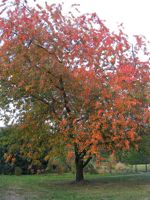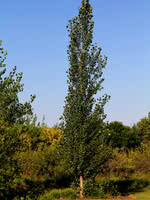Mon-Fri 9am - 5pm Mountain time
Sundancer Poplar vs Black Cherry
Prunus serotina
Populus x ACWS151
NOT AVAILABLE THIS SEASON - MIGHT RETURN
Black Cherry is common in eastern North America but a rare find elsewhere. This tree is shade tolerant and is often found in old fields, forest openings, and along fencerows.
The fruit is edible and is commonly used to flavor rum and brandy. It is also edible and often eaten fresh or used in wine or jelly. Black Cherry trees typically begin producing fruit when they are 10 years of age.
Black Cherry wood is a rich reddish-brown color and is strong, making it valued in cabinetry and woodworking. It is often used in reclamation as well.
The leaves can poison livestock as they contain cyanide derivatives and precursors. However, many have noted that deer still seem to browse their trees with impunity and birds and other animals eat the fruit when available.
The Sundancer Poplar is a fast-growing, columnar hybrid that is resistant to Bronze Leaf Disease. Developed at the Agroforestry Centre in Indian Head, Saskatchewan, this cold hardy tree is well-suited to the Canadian prairies and northern regions.
Adaptable to various soil conditions and drought-tolerant once established, the Sundancer Poplar is an excellent choice for lining properties and roads or creating an attractive hedge.
Black Cherry Quick Facts
Sundancer Poplar Quick Facts
Toxicity: bark and wilted leaves toxic to livestock

